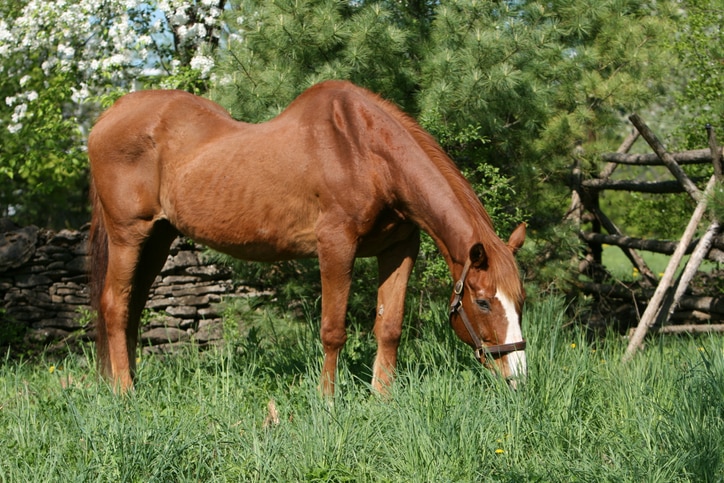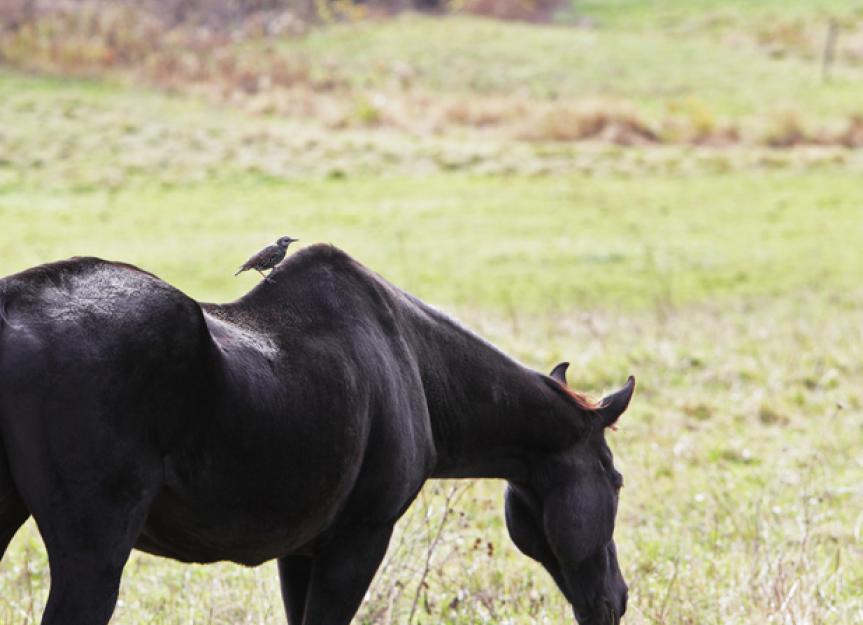Swayback, also known as lordosis, is one of several types of equine back malformations, which also include roach back (hump back) and scoliosis. These are all deviations of the spine and supporting structures (mainly ligaments and muscle) from their normal position.
Key Takeaways
- Swayback is the appearance a horse has when the spine makes a U shape from the withers to the pelvis, instead of a more horizontal appearance.
- Although it looks odd, swayback is not detrimental to riding.
- The exact cause of swayback in horses is not fully understood, but is likely due to factors including genetics, age, and conformation.
What Is Equine Swayback?
Swayback in horses is when the supporting structures (ligaments) of the horse’s spine are weakened. The weakness in the horse’s back allows the spine to dip. A swayback horse’s spine is no longer horizontal but makes a U shape. This can occur in varying degrees, from a subtle dip to a severe dip.
Swayback is not very common in horses, which is why people may be surprised when they see it. The condition is generally present in 1% or less of the horse population. However, it can be more common in certain breeds, such as the American Saddlebred.
Horse swayback occurs gradually over time, so it’s not considered a medical emergency. Swayback does not harm the horse, and often the horse can still be ridden with the proper tack.
Unlike humans and dogs, where a deviation of the spine like scoliosis can have severe effects on movement, horses with swayback do not experience any restriction in movement or ability to carry a rider.
Symptoms of Equine Swayback
The telltale sign of swayback in horses is the conformation change or “sinking” of the horse’s back to a “U” shape instead of a horizontal line from withers to pelvis.

Other symptoms may include:
What Causes Swayback in Horses?
Swayback most commonly develops as a horse ages. The ligaments that hold the vertebral column in place become less supportive, which allows the vertebra to sink down.
A horse can still have good topline muscles if they are in regular work.
Horses with added weight to the abdomen from aging have weakening abdominal muscles; broodmares that have had many foals are also more likely to experience sinking of the spine.
Horses with a longer back may be more prone to developing swayback.
Rarely, horses can be born with birth defects of the spine. These vertebral malformations can cause swayback to develop at an earlier age.
How Veterinarians Diagnose Equine Swayback
Swayback is a visual diagnosis, meaning your veterinarian will look at the horse’s back conformation to determine a diagnosis. They may also feel along the horse’s back to check for sensitive or painful areas. A horse in pain may pin their ears or move away if a sensitive area is touched.
At this time, X-rays can be taken to also check for secondary problems that can develop in horses, such as kissing spine, a painful condition that develops when a horse’s vertebrae rub together.
Equine Swayback Treatment
There is no cure for swayback, as it’s a conformational change to the horse’s body.
Unless a horse has other secondary problems developing, like kissing spine, treatments such as back injections are not necessary.
Recovery and Management of Equine Swayback
Regular Exercise
Routine exercise can help manage swayback in horses. Most horses with swayback can still be ridden with proper fitting saddles and saddle pads.
Horses can be ridden by keeping their head carriage low or they may be asked to perform backing exercises, both of which will help strengthen back muscles.
Working over ground poles and stretching exercises can also help the horse maintain its core muscles. These tasks require that a horse use their back and abdominal muscles.
Proper Saddle Fit
Having a professional saddle fitter check your saddle fit yearly is one of the most beneficial things you can do.
A horse may need a special saddle pad or half pad such as the WeatherBeeta Horse Memory Foam Comfort Half Pad that varies in thickness. Saddle pads made specifically for swayback are thicker in the middle and thinner at the edges.
As the swayback horse ages, the back may continue to sink further, which is why yearly evaluation is important.
Preventing Swayback in Horses
There is no way to prevent swayback in horses. There are no environmental or nutritional factors in the development of swayback.
However, always try to keep your horse at an ideal body weight and fitness level, which will contribute to a stronger top line and core muscles. This potentially allows a horse to have a longer riding career whether swayback develops or not.
Equine Swayback FAQs
Can swayback be corrected in horses?
Swayback cannot be corrected. However, maintenance exercises can be used to potentially delay the progression of the defect.
What age do horses get swayback?
Horses most commonly get swayback when they are older, typically 25 years of age or older. It occurs rarely in young horses, and in those instances the condition is mainly caused by a birth defect of the spine.
What saddle is best for a swayback horse?
Saddle fit depends on each particular horse and what degree of swayback they have, as well as the length of their back. An owner would need to make sure the saddle is not causing abnormal pressure points due to the abnormal conformation of the back.
A special saddle pad or half pad may help prevent the saddle from applying pressure at the front and back, but not in the middle.



